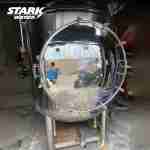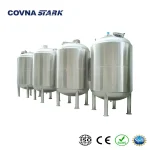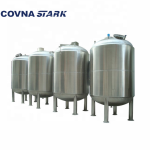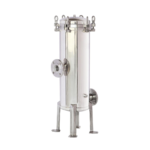Understanding Mixing Tanks: A Key Component in Industrial Processing
Mixing tanks play a critical role across industries—from chemical blending to food processing and water treatment. These vessels are designed to mix, blend, or homogenize liquids, powders, and chemicals under controlled conditions. But with so many designs and materials available, what exactly is a mixing tank, and how do you choose the right one?
This guide breaks down the core types of mixing tanks, their industrial applications, and what to consider during selection. Whether you're an engineer evaluating stainless steel tanks or a buyer looking for customizable solutions, this article offers practical insights to help you make informed decisions.
Types of Mixing Tanks: Materials and Configurations
Mixing tanks are available in a wide range of materials and configurations, each suited for specific industrial processes. Choosing the right type depends on your application’s chemical compatibility, temperature, hygiene requirements, and budget.
1. Stainless Mixing Tank
Stainless steel is the gold standard for industrial mixing. It offers exceptional corrosion resistance, hygienic performance, and long service life, making it ideal for food-grade, pharmaceutical, and water treatment applications. A stainless mixing tank is easy to clean, supports CIP (clean-in-place) systems, and handles aggressive chemicals or high temperatures effectively.
2. Plastic (Polyethylene or Polypropylene) Tanks
Plastic tanks are a cost-effective alternative for non-corrosive fluids at ambient temperatures. They are lightweight and easy to install, often used in agriculture, basic water storage, or low-viscosity mixing processes.
3. Jacketed Mixing Tanks
Designed for thermal control, jacketed tanks are equipped with an outer shell that allows hot water, steam, or coolant to circulate around the vessel. They're commonly used in cosmetics, food, and chemical industries where temperature-sensitive reactions occur.
4. Pressurized or Vacuum Mixing Tanks
These specialized tanks are engineered to operate under vacuum or pressure, ensuring controlled processing environments for sensitive compounds or volatile liquids. They typically require reinforced structural design and precision instrumentation.
Main Industrial Applications of Mixing Tanks
Mixing tanks are indispensable across many industries that involve the preparation, blending, or processing of liquid-based products. Below are some of the most common application areas:
- Water Treatment: Used for chemical dosing, pH balancing, and flocculation. Stainless steel tanks are ideal due to their resistance to corrosion from harsh water treatment chemicals.
- Food and Beverage: Blending of ingredients, homogenization of liquids, or fermentation processes require hygienic stainless steel tanks to ensure product safety and quality.
- Chemical Processing: Chemical manufacturing often involves reactive or corrosive substances. Jacketed or pressurized stainless mixing tanks offer both chemical resistance and temperature control.
- Pharmaceutical: High-purity blending processes demand sanitary-grade materials like SUS316L stainless steel and CIP/SIP compatibility.
- Cosmetics: Mixing lotions, gels, and serums requires uniform blending, temperature stability, and strict hygiene standards — features best supported by stainless mixing tank systems.
Across these industries, the STARK Stainless Mixing Tank has become a trusted solution thanks to its durability, customization options, and suitability for international export standards.
How to Choose the Right Mixing Tank
Selecting the right mixing tank is not just about capacity — it’s about matching the vessel to your process requirements, space constraints, material compatibility, and industry standards. Below are the key factors you should consider when choosing an industrial mixing tank:
- Material Compatibility: For reactive or hygienic applications, stainless steel (SUS304 or SUS316L) is preferred. It resists corrosion and meets food/pharma standards. For less demanding uses, HDPE or PP may suffice.
- Capacity and Batch Size: Consider both current usage and future expansion. STARK offers customizable mixing tanks from 100L to over 30,000L based on your operational flow.
- Tank Shape and Geometry: Cylindrical vertical tanks are space-efficient and compatible with bottom-entry mixers. Conical bottoms aid drainage; flat bottoms simplify placement.
- Agitation Requirements: Define whether your process needs gentle stirring, high-shear mixing, or temperature-sensitive homogenization. STARK tanks support paddle, propeller, or turbine agitators as needed.
- Thermal Needs: For heating or cooling, choose a jacketed mixing tank or integrated coil system. Temperature control is vital in food, pharma, and chemical synthesis.
- Installation Conditions: Will the tank be indoors, outdoors, or on a skid? Consider insulation, support frames, and seismic or hygienic mounting requirements.
If you're unsure where to start, the STARK Stainless Mixing Tank is engineered to meet the needs of a wide variety of industries, with expert consultation and global export support included.
Conclusion: Mixing Tank Selection Starts with Process Understanding
Whether you're blending food ingredients, dosing chemicals, or managing high-purity liquids, selecting the right mixing tank is critical for operational success. From material compatibility to thermal control and agitation methods, each element must align with your process and compliance needs.
If your application demands a durable, easy-to-clean, and customizable solution, a stainless mixing tank is likely your best option — especially in industries where hygiene, longevity, and export readiness matter.
At STARK, we offer fully customizable stainless steel mixing tanks engineered for global industrial use. With CIP-compatible designs, mirror-polished interiors, and international standard connections, our tanks are trusted by clients across North America, Southeast Asia, and the Middle East.
To request a quote or technical consultation, please contact us via WhatsApp at +86 185 2015 1000 or email us at [email protected].









